Kelty Hula House Tent Review
First Impressions
Camping on the Northern California coast can test even the best tent. Gusty winds, blowing sand and cold, damp fog are but a few of the challenges. We chose to put the Kelty Hula House 4 through its paces on a trip to Bodega Bay and encountered all those factors. Luckily for us, the Hula House was more than up to the task.
The Kelty Hula House 4 withstood winds blowing consistently above 15 miles per hour and gusting above 25 thanks to the solid construction and roughly 14 stake and guy-out points. The combination of mesh interior and nylon exterior walls effectively eliminated condensation. The interior was so spacious and comfortable, it brought a smile to my face every evening as we bedded down.
Features
Kelty built the Hula House as a two-wall, three season tent. The interior walls are almost completely mesh to aid in ventilation. The bathtub floor wraps up the sides and the seams are factory taped to protect the interior from moisture. The fly provides the exterior wall and it too is factory taped to prevent leaks.
The Hula House uses a pretty traditional design coupled with a unique addition that substantially increases interior space. The traditional part is the center crossing pole set. Hundreds, maybe thousands, of tents employ this approach. Simply feed two long poles diagonally across the center, pop the ends into a grommet and you’re done . . . well, not quite with the Hula House. Kelty added an innovative spin with a third pole – a completely round hoop – that attaches about shoulder height, slightly canted from front to back, that pulls the exterior outward for near-vertical side walls. With this addition, the interior feels absolutely huge in comparison to other four person tents.
Specs
Dimensions without fly: 96”x96”x72”
Dimensions with fly: 96”x146”x72”
Weight: ~12 lbs.
Configuration: Two wall, three season
Doors: 1
Although it’s easy to assemble and attach the hoop, disassembly can be a challenge. Quick tip, hold the hoop at a junction point and push it gently away from you – either towards a partner or into the ground – to take pressure off those junctions so they slide apart. Then disassemble the pole two sections at a time. Despite this small challenge, the Hula House can be easily pitched or taken down by one person in less than 10 minutes.
In addition to the cool pole design, the Hula house has pockets at all four corners, near silent zippers, color-coded attachment points for the fly, and a large vestibule (22 square feet or so) for storage created by the fly.
What’s missing from the Hula House? Not much. It be nice to have a gear loft. Kelty doesn’t provide one with the tent, nor do they seem to sell one as a separate accessory. I found one from another manufacturer that fit perfectly (a North Face Gear Loft #2) once we removed the extra webbing at the corners. Additional stakes would help too. Kelty provides eight with the Hula House 4 which are not enough for all the guy-out points. And finally, it would be nice to have an alternative way of securing the vestibule door so that it could be only partially opened. Pretty minor stuff.
Fit
With the Hula House 4, Kelty built one of the largest four person tents on the market. When I first looked at the box I was knocked over by the dimensions. The tent is eight feet square and an amazing six feet tall inside. In a market that’s flooded with tents that top out around four feet tall – and require you to lay flat while dressing – the Hula House is a welcome anomaly.
Now to answer the age-old question, can you really get four people in a four-person tent? The answer is “it depends.” If you’re traveling light in mummy bags and sleeping pads, you bet, it can be done. But if you’re a tricked out car camper with air mattresses and all the comforts of home, you’ll be hard pressed to fit four inside. If you need more space, check out Kelty’s six person version of the Hula House.
Final Verdict
The Kelty Hula House is one helluva tent. With a six foot ceiling height and hoop pole system, it bests just about everything else out there for interior space and feels enormous inside. And the construction and factory seam sealing provides top-notch protection from the elements. If you’re looking for a four or six person base camp tent, you owe it to yourself to check out the Hula House.

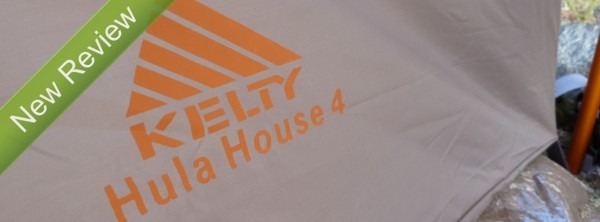
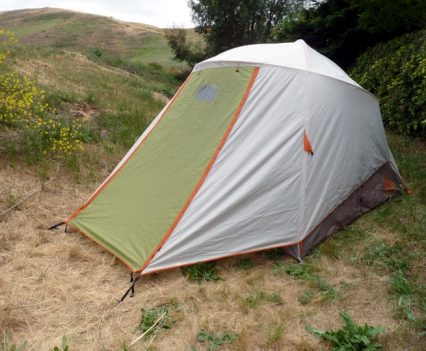
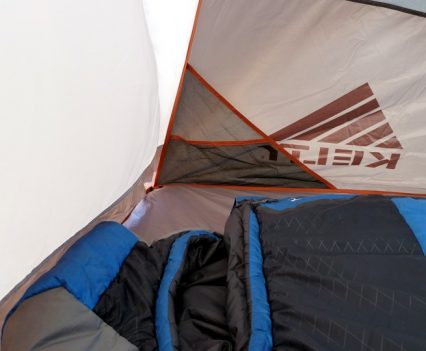
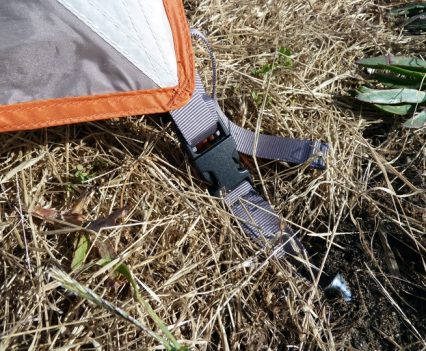
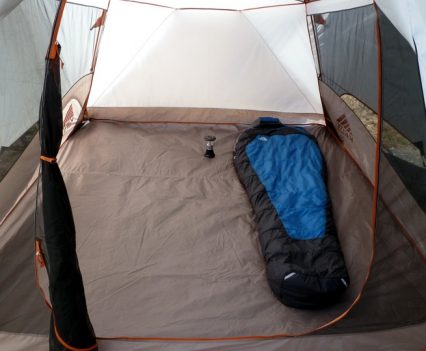




September 15, 2011
You’ve got great insights about three seasons tent, keep up the good work!
July 5, 2012
There are a couple of mistakes in this review. First, it does not have a bath-tub style of flooring (where the floor does not end at the seams but rises up the walls). This design is actually ArcEdge, a Kelty patented method that is supposed to “lift the floor seams up off of the ground.” The problem is, when the tent is staked these seams are at the perimeter and do not rise up the walls like a bathtub design.
Second, it is actually only 92 by 92 inches (possibly 93 inches, if you really stretch them). So, you say, what’s the difference – when it supposed to be 96 x 96; why, that’s only 4 inches short on each side?
Well, it can mean the difference between two in sleeping comfortably, or three adults cramming into the tent. But there is no way that four persons will be able to sleep in it, unless you take along bunk beds, or sleep in shifts. And even if you turn the sleeping bags to their sides, there is no way to fit four persons in.
But then, we who have been camping know that, and make allowances for it; it is the unwary new camper that feels a little screwed when they first pitch that Kelty tent, expecting to put the group into it.
Yes, Kelty does short-change you when it comes to the stakes. There are only eight of them and the way I count it (with two stakes going into the vestibule and one to tie down the rear) perhaps they meant it when they called it a freestanding design that you can get by not pegging the four corners! Where the hell are the other ones?
But the worst thing that remains is Kelty’s warranty work. If you need to return something, and that may be because out of the box something is screwed up (like mine!), you are going to have to wait for Kelty to approve it, and then you are going to have to pay to send it to them to make good on that warranty.
And, that is not all, because you will have to wait until Kelty’s warranty people get around to it (and most of them are on vacation during the camping season), and they will finally fix it and send it back to you – maybe in time to camp out again.
If you are going to get a Kelty Hula House, and can get a great deal on it, make sure that your retailer will take care of the warranty work. Like REI, Mossejaw, Altrec and Backcountry Edge. Dealing with Kelty can be a royal pain in the Keester!
July 6, 2012
Jim and Beamer:
Thanks for the comment. And sorry you’re having problems with Kelty’s warranty dept. After two seasons of solid use, we continue to be impressed with the tent. We’ve had no water penetration and solid performance in a range of conditions. You’re right about the size, it’s tight for four people, but still doable. We’ll test Kelty’s warranty dept ourselves soon as we get ready to request replacement sections for tent poles and will keep you posted.
Matt K @ GearGuide
July 6, 2012
Matt, I have been having extensive conversations with Tim Stanley of American Rec, the Kelty Service people. They have been fruitful, to say the least. Not that the warranty people have wakened, but there is progress with Kelty. First, I am receiving a replacement for the “hula hoop” that was damaged by an inadvertant improper insert and it will come directly from Tim. He said that BackCountry Edge could take care of it (which I knew), but because it was something that was covered by the warranty, and it was new out of the box, they would cut out the middleman.
On the stakes, they said that because 80% of the campers did not stake out their tents they did not feel a need to include more than a token number. After discussions, and pointing out that they did send out (even if I use my own) the guy-outs for all of their guy points, but only one stake for the four of them, they are going to resolve that one. The thing that I was rather direct on was the fact that there was no communication on that matter, letting the customer know until they used the tent that there was only one stake for the four points.
Finally, they are setting up a Hula 4 just to see if the manufacturer has been cheating a little bit on the floor size. I don’t know what their answer will be, but Tim has assured me that it will be resolved. As I understand it, there has always been some leeway in those dimensions – but Tim says that 4 inches to a side is not what they expect. And I believe it will be resolved.
Remember, with the ArcEdge you need to keep the sleeping bags away from the sides and that cuts down on some of the floor area. What did you have in mind when you said it would be close when you had four in the tent? Even if you put all of the shoes and sox in the vestibule, and slept in the clothes you hiked in, unless you have some children in short sleeping bags they just won’t fit. Even rotating mummy bags! I hope everyone used fresh deoderant for your experiment.
And anyway, the four-person is just a construct to give us a rationale between tent sizes.
I have never had an issue with water penetration with any of my Kelty Trail Dome 6’s, and I have had two of their models. My only problem with them is their height and the lack of guy-outs in windy conditions. That is why I have moved to the Big Agnes Wolf Mountain 6 tent, with this Hula Hoop tent (while out of the box) as a back-up. I know you gave yours some wind, but nothing like I have experienced but feel that it can survive bigger blows with the extra framing given the hula hoop.
But it will see some service, like at Hovenweep National Monument where the Big Agnes cannot fit, because of the tent pads.
Jim and Beamer